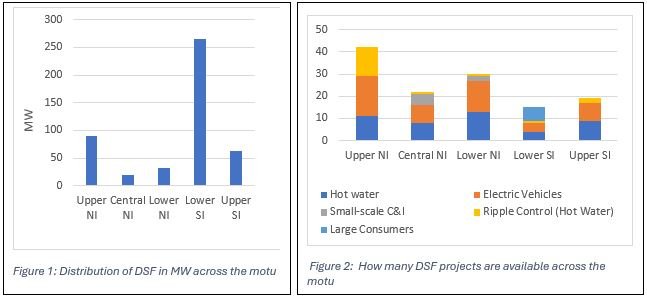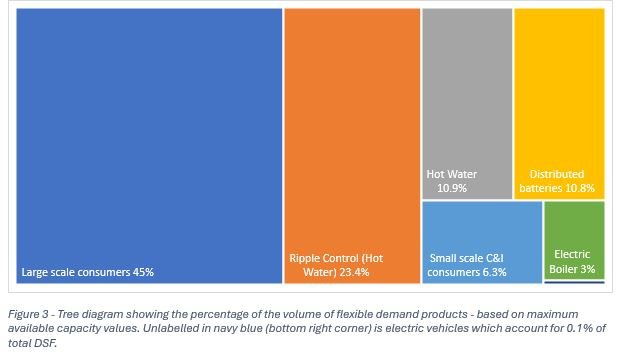Eye on electricity
How demand-side flexibility can contribute to security of supply
- Consumers
- Generation
Electricity is a unique product because its generation and consumption must always match, but demand changes over the course of the day and most generation needs to be immediately consumed. Yet some technologies, such as batteries, allow us to store generation for later use.
Demand-side flexibility (DSF) is a term that describes situations where consumers change the time or the amount of their electricity consumption. By reducing or shifting demand, it reduces the amount of generation needed at the time. This can lower costs for consumers and support security of supply in the electricity market.
A common example of DSF is the control of consumers’ hot water cylinders by distributors. In these situations, the customer usually pays a lower network charge in exchange for allowing the distributor to turn off their hot water cylinder for a limited number of hours per day for network and grid control (or in emergency situations). This offers a win-win situation, where savings are directly passed to the consumer.
But we also want more DSF to take part in the electricity spot and reserve markets (learn more about reserves), through commercial arrangements with retailers or aggregators. DSF is one of the most likely sources of new flexibility in the immediate future. It can be used to manage both the variability of intermittent generation (like wind and solar) and demand peaks (learn more about firming intermittent generation). This is particularly important as we move away from thermal generation and electrify New Zealand’s economy.
A recent survey shows that there could be around 450MW of demand flexibility available now
Earlier this year, the Electricity Authority sought information from industry on the availability of DSF resources.
We received 13 responses and would like to thank everyone who took the time to fill in the survey and provide insights. The survey showed approximately 450MW of demand-side flexibility could be available now. This included 160MW of reported hot water and ripple control, which may already be offered into the reserve market.
Demand-side flexibility is everywhere across the motu and can take a variety of forms
Most of the DSF quantity reported in our survey was in the lower South Island (Figure 1), while most individual projects reported were in the upper North Island (Figure 2). This reflects the composition of those who took part in the survey, and the resources they chose to disclose to us. It also shows that, despite the small number of survey respondents, DSF resources are distributed across the motu. This is beneficial for overall management of the electricity system.
While the responses do not reflect all the actors and technologies involved in DSF, the survey still offers a useful snapshot of what resources could be available across Aotearoa New Zealand.

Large scale consumers provide most of the demand-side flexibility reported
Curtailing large consumers’ demand accounts for almost 46% of the available flexible capacity reported – around 210MW (Figure 3). This form of DSF is often the result of a contract between large-scale electricity consumers and a generator. While there are only a small number of large industrial consumers in Aotearoa New Zealand, these agreements tend to represent a significant amount of megawatts of demand response.

Retail agreements are including hot water control
Figure 3 also shows the large potential contribution ripple control (~110MW) and hot water control (~50MW) could make to DSF. These two categories use different technologies to switch off hot water cylinders. On the one hand, ripple control has long been used by distribution companies for grid and network control. On the other hand, hot water control is emerging specifically as a form of demand response in the retail market thanks to recent technological developments.
These numbers confirm a recent trend that sees the control of hot water cylinders starting to move away from pure distribution control to more commercial arrangements. Public examples include Contact Energy’s ‘Hot Water Sorter’ initiative and Octopus Energy’s hot water trial. This shift suggests the emergence of market-based mechanisms to incentivise this form of DSF and to share the benefits directly with consumers. However, it also means that the use of these resources will have limitations which are based on how much and for how long consumers will agree to switch off their resources.
Demand-side flexibility is a distributed resource and can work with a variety of consumers
The reported DSF from electric vehicles and batteries was spread across the country. Its amount remains limited, but we expect these technologies to rapidly scale up.
Small-scale commercial and industrial resources are still a small provider of DSF, but their contribution is expected to grow, with more facilities such as data centres, cold storage, and manufacturing plants joining DSF schemes.
Consumers still have their say with demand-side flexibility
Although the survey responses indicated there is 450MW of DSF theoretically available in the market, its availability can vary depending on customers’ preferences. For instance, large consumers often put restrictions on the usage of the resource and require several days’ notice before making the capacity available. Additionally, ripple control is quickly available but can only run continuously for a few hours to ensure households are not noticeably affected. Finally, electric vehicles need to be plugged in and connected to the distribution network for them to be used as DSF, so the development and distribution of smart chargers will also affect its potential use for DSF.
The Authority is committed to facilitating demand-side flexibility
We recognise that consumers, large and small, and aggregators (entities that groups together different resources) have different incentives and mechanisms to take part in the wholesale electricity market.
The Authority is committed to working with industry to enhance demand-side participation in the market to promote both competition and flexibility.
We encourage anyone who may have additional DSF and/or would like to discuss ways to increase DSF uptake to contact us at OperationsConsult@ea.govt.nz
Related News
Clarification on small business eligibility for peak export rebates
In July 2025 we introduced a requirement that, from 1 April 2026, electricity distribution businesses will need to pay negative charges (rebates) to households…
Next steps on multiple trading relationships and switching
The Electricity Authority Te Mana Hiko would like to thank everyone who provided feedback in our June-July consultation on multiple trading relationships…
How marginal electricity spot pricing reflects cost
In the New Zealand wholesale electricity market, the price paid to dispatched generators is the nodal ‘spot price’, which is priced to reflect the ‘margina…